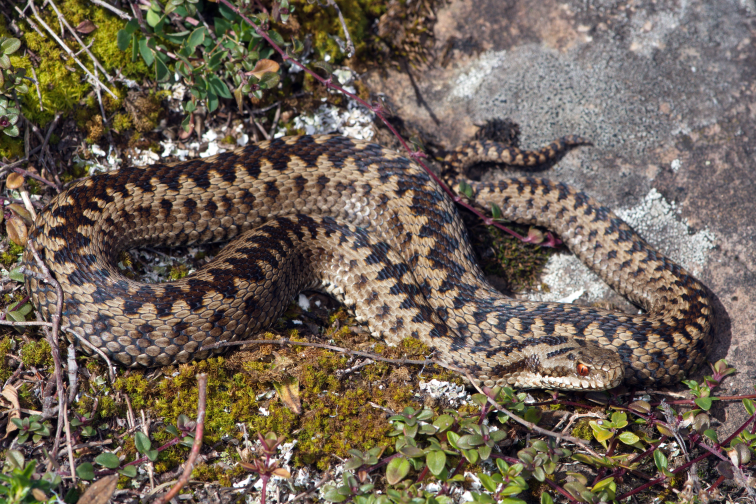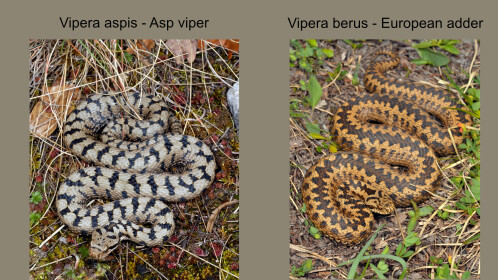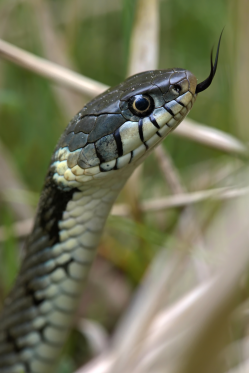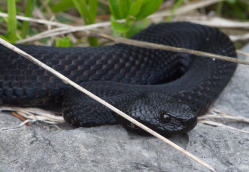It is not a common occurrence to encounter a snake out in nature in Switzerland. Snakes are extremely shy animals and, with the loss of their natural habitats, their populations are declining. All snakes in Switzerland are protected, they are highly endangered and some are facing a high risk of extinction.
«I’ve been bitten by a snake», Part I
What should you do after a snakebite?
It is rare to encounter a snake
Two indigenous snakes are venomous
There are two venomous snake species in Switzerland: the asp viper (Vipera aspis) and the European adder (Vipera berus). Besides these two venomous vipers, all other snakes native to Switzerland are non-venomous and belong to the colubrid family. The slow worm is not a snake but is often mistaken for one. It’s actually a lizard and is completely harmless.
Humans are not tempting prey for snakes
Being bitten by one of the two indigenous venomous snakes is even more unlikely than encountering a snake in the first place. There are an estimated 10 to 20 bites by indigenous venomous snakes per year. However, there is no official reporting system for snakebites in Switzerland and not all snakebites are recorded by Tox Info Suisse. Snakebites primarily happen in the warm seasons when people and animals are both more active. As with all snakes, neither of the indigenous venomous snakes are at all aggressive. A snake will only bite a person in self-defence, humans are not prey. The risk of being bitten is mainly as result of the snake not noticing a person and being taken by surprise. This may happen if you put your hands in the immediate vicinity of the animal (e.g. when picking plants, reaching for the snake) or treading on a snake when wearing light footwear.
Snakebite: What should you do?
- Keep CALM!
Anxiety, panic or vigorous physical activity can accelerate the spread of venom in your body. - Contact Tox Info Suisse (145).
- Do not hunt or even kill the snake under any circumstances (not even for photographic evidence!).
- Visit the closest hospital.
First-aid measures in situ:
- Keep the bitten person calm.
- The person with the bite should sit or lay down (ideally in the shade).
- Immobilise the bitten limb (arm sling, leg splint).
- If worn, remove rings, watch and tight-fitting clothing.
- Disinfect the bite wound.
- Go to the nearest hospital (smooth transport, no physical exertion).
- If symptoms are life threatening, call 144 for emergency help.
Never: Bind, suck, cut or cauterise the bite wound.
Keep calm and go to the hospital
- Every snakebite is potentially hazardous but thanks to modern medicine, good treatment is readily available.
- In Switzerland, the last fatality after a venomous snakebite was recorded in the 1960s.
What you see in movies is NOT good advice: Binding, suction etc.
After any snakebite you should: Keep calm and go to the nearest hospital. And forget about any scenes with snakes you’ve seen in movies and horror stories you’ve heard. Worry, panic and intense physical activity can, in the worst-case scenario, accelerate the spread of the venom in your body.
Do not bind the wound: Binding a limb restricts blood circulation, pinches nerves and can cause tissue damage.
Do not apply suction: Neither sucking with your mouth nor using a vacuum pump will reduce the effect of venom in the body. In the worse-case scenario you run the risk of further damaging the local tissue or inflaming the wound.
Do not cut out/into or cauterise the wound: These actions do not reduce the amount of venom in the body. And they can make the wound swell or bleed more, and cause the wound to become infected.
Snakebite symptoms: from harmless to severe – anything is possible
Symptoms after a snakebite generally reach their peak after a few hours. The progression can vary greatly. For a «dry bite», the venomous snake does not inject any venom and there are no symptoms of poisoning. According to Tox Info Suisse records from 1997 to 2018, this is the case for about one in ten snakebites. Nevertheless, with any bite it is possible for the snake to inject a large quantity of venom. It is only possible to say for certain that it is a «dry bite» after observation in hospital for several hours. Severe symptoms appear in about one in ten venomous snakebites (e.g. allergic or allergy-like reactions, severe circulatory problems or severe swelling).
Good treatment for snakebites is readily available in Switzerland
Antivenoms (antidotes) are readily available in Switzerland. They are only used in hospital for one in five snakebites. As with any bite, snakebite wounds may become inflamed. At the hospital, the wound will be disinfected and the patient will be asked if they have sufficient tetanus protection or if they need a booster vaccination. Thanks to modern medical care, a snakebite is easily treated. Modern medical care means that good treatment for snakebites is readily available and in Switzerland, the last fatality after a venomous snakebite was recorded in the 1960s.
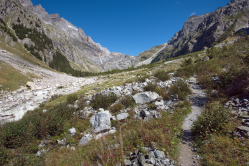
Further information
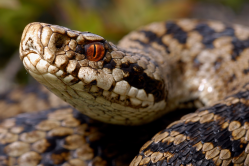
Part II of «I’ve been bitten by a snake» will cover the following questions: How do I know if it was a venomous snake? Is it important to know which type of snake bit me? Where can I find information on indigenous snakes?
Read more here
June 2024


